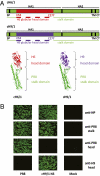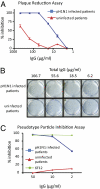Hemagglutinin stalk antibodies elicited by the 2009 pandemic influenza virus as a mechanism for the extinction of seasonal H1N1 viruses
- PMID: 22308500
- PMCID: PMC3289326
- DOI: 10.1073/pnas.1200039109
Hemagglutinin stalk antibodies elicited by the 2009 pandemic influenza virus as a mechanism for the extinction of seasonal H1N1 viruses
Abstract
After the emergence of pandemic influenza viruses in 1957, 1968, and 2009, existing seasonal viruses were observed to be replaced in the human population by the novel pandemic strains. We have previously hypothesized that the replacement of seasonal strains was mediated, in part, by a population-scale boost in antibodies specific for conserved regions of the hemagglutinin stalk and the viral neuraminidase. Numerous recent studies have shown the role of stalk-specific antibodies in neutralization of influenza viruses; the finding that stalk antibodies can effectively neutralize virus alters the existing dogma that influenza virus neutralization is mediated solely by antibodies that react with the globular head of the viral hemagglutinin. The present study explores the possibility that stalk-specific antibodies were boosted by infection with the 2009 H1N1 pandemic virus and that those antibodies could have contributed to the disappearance of existing seasonal H1N1 influenza virus strains. To study stalk-specific antibodies, we have developed chimeric hemagglutinin constructs that enable the measurement of antibodies that bind the hemagglutinin protein and neutralize virus but do not have hemagglutination inhibition activity. Using these chimeric hemagglutinin reagents, we show that infection with the 2009 pandemic H1N1 virus elicited a boost in titer of virus-neutralizing antibodies directed against the hemagglutinin stalk. In addition, we describe assays that can be used to measure influenza virus-neutralizing antibodies that are not detected in the traditional hemagglutination inhibition assay.
Conflict of interest statement
The authors declare no conflict of interest.
Figures



References
-
- Thompson WW, Comanor L, Shay DK. Epidemiology of seasonal influenza: Use of surveillance data and statistical models to estimate the burden of disease. J Infect Dis. 2006;194(Suppl 2):S82–S91. - PubMed
-
- Johnson NP, Mueller J. Updating the accounts: Global mortality of the 1918-1920 “Spanish” influenza pandemic. Bull Hist Med. 2002;76:105–115. - PubMed
-
- World Health Organization 2009. Dr. Margaret Chan: Statement to the Press: World Now at the Start of 2009 Influenza Pandemic. Accessed December 28, 2011. Available at http://www.who.int/mediacentre/news/statements/2009/h1n1_pandemic_phase6....
Publication types
MeSH terms
Substances
Grants and funding
- T32 AI007647/AI/NIAID NIH HHS/United States
- HHSN266200700006C/AI/NIAID NIH HHS/United States
- U19AI089987/AI/NIAID NIH HHS/United States
- U19 AI057266/AI/NIAID NIH HHS/United States
- HHSN2662000700010C/PHS HHS/United States
- T32GM007280/GM/NIGMS NIH HHS/United States
- T32 GM007280/GM/NIGMS NIH HHS/United States
- U19-AI057266/AI/NIAID NIH HHS/United States
- HHSN266200700010C/AI/NIAID NIH HHS/United States
- U19 AI089987/AI/NIAID NIH HHS/United States
- U01 AI070469/AI/NIAID NIH HHS/United States
- K01 ES019156/ES/NIEHS NIH HHS/United States
- HHSN272200800003C/AI/NIAID NIH HHS/United States
- U54 AI057158/AI/NIAID NIH HHS/United States
- UO1 AI070469/AI/NIAID NIH HHS/United States
- J 3232/FWF_/Austrian Science Fund FWF/Austria
- U54 AI057158-04/AI/NIAID NIH HHS/United States
- U19 AI057266-06S2/AI/NIAID NIH HHS/United States
LinkOut - more resources
Full Text Sources
Other Literature Sources

